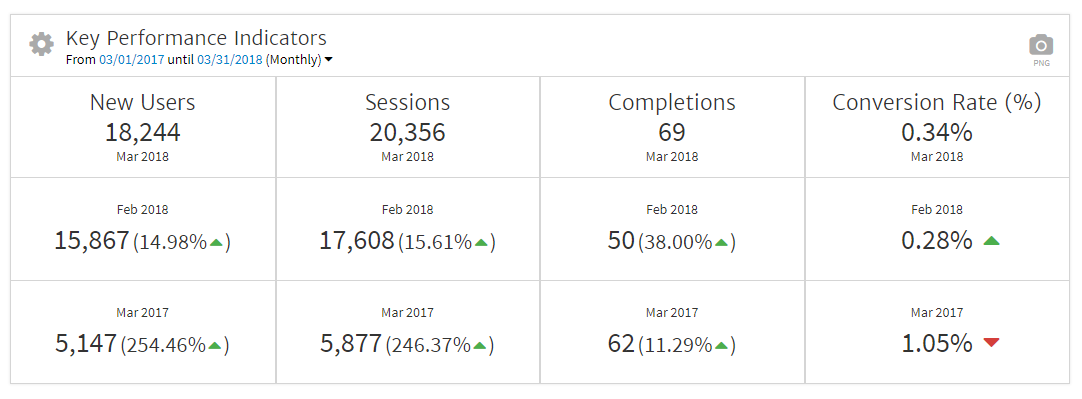How Much Does Client Education Matter to Marketing Agency Success?
Lead Prospecting
Before an organization becomes a client, they are a prospect or a lead. Their existing level of knowledge will invariably inform which services they inquire about during their initial contact and early conversations. In many cases, their perception of their needs and your discoveries of their problems may not align. It’s during this earliest stage that client education can go a long way toward setting the tone for the business relationship.
A prospect might indicate that they are desperately in need of better SEO. You ask “why?” and they respond that sales are down from organic search. However, upon further investigation into their analytics, you see their actual rankings and visibility have never been better.
What’s down though is both click through and conversion rates and the real culprit behind diminishing sales turns out to be a neglected mobile experience. The dominant share of their visitors from search comes from mobile devices where users encounter a less-than-friendly mobile site.
Even though this issue appears within the organic search channel, it is not fundamentally an SEO problem. It’s actually more of a design and user experience problem. Content marketing, on-page optimization, and link building aren’t going to solve that.
How to Bring In Education
At this point, your questions matter as much as your answers and explanations. Take some time to better understand what a client perceives to be their needs and why. Don’t be afraid to ask probing questions like “How did you initially define your problem”, to help get to the root of a misplaced assumption. On a higher level, when a client expresses interest in a channel, tactic or metric, make sure to ask “Why is that important to your organization?” It is also critical to inquire about the business goals a prospective client hopes to achieve with your services. We all get excited by a new lead and we all feel the rush of closing a deal. But don’t shortchange those early conversations or your initial research.
It’s easy to get so wrapped up in putting together a proposal that gives the prospect what they requested that you don’t stop to make sure their request addresses their actual needs and goals. But if that first step is missed, the entire account could be doomed.
Statement of Work
A client’s level of knowledge fundamentally shapes what they are willing to pay for, how much they’ll invest, and the timelines in which they’ll expect results. It will also affect the deliverables that are spelled out in the statement of work.
Even if you are confident that during your pre-contract communication period they truly understood their service needs and goals, they may not have a full understanding of what those services entail, how they will be executed, how much they cost, and what timetables are realistic.
For example, while you can launch, run, and report on a paid search campaign within 30 days, it can take a few months to find the right balance of targeting and bidding strategies. Additionally, organic search or social media channels can require even longer runways for traction and success. Some strategies require a greater initial investment in content or creative that doesn’t immediately provide a return on investment (ROI). If the client’s perception is that different channels should have similar initial investments and timetables that might be a big red flag. It will be during the finalization of the Statement of Work (SOW) that any disparities in understanding deliverables, budget, and timelines should be surfaced and resolved.
How to Bring In Education
Again, your questions and their answers will set expectations. Ask how the client will be gauging the value of the services and the overall effectiveness of the campaigns before finalizing any SOW. Candid discussion ensures that you’re all focused on the right key performance indicators from the outset. Most importantly, ask when their valuations will take place. If there are wide gaps in timetables or valuation processes, these should be reconciled as much as possible before the contract is signed and campaigns are launched.
Account Management
A client’s level of knowledge also impacts the frequency and nature of their day to day inquiries, questions, and concerns. Now that they are investing in digital marketing services, rest assured that they will be making at least some effort to self-educate themselves, for better or for worse. This may mean a litany of questions, as they now dive into both basic topics and emerging industry trends. These questions will not always be expected, or budgeted for, and will only sometimes come during the most convenient parts of the week and day
There may also be little to no correlation between the urgency of the question and the actual significance and implications of the concern. A panicked “URGENT – PLEASE REPLY” email might amount to nothing and a casual aside or one-off question might reveal a previously unnoticed, but serious, issue that requires immediate attention.
How to Bring In Education
Don’t brush off the random client questions or concerns, as that will have a negative impact on day to day account management. But do consider dividing your responses into parts or multiple phases. First, send an immediate reply acknowledging receipt of the concern with a brief but overall assessment of the significance of the underlying issues. Establish if this is something to actually worry about and address immediately, or something worthy of discussion but not a code-red concern. Also, provide an ETA for a follow-up response. Then later in the day, or week, address the question on a scale and timeframe proportional to the client’s budget for consultation and the actual significance or severity of the question.
Reporting
A client’s level of knowledge impacts their ability to understand what the agency is tracking, measuring, reporting on, and most importantly, why these metrics matter. Books and some excellent blogs are dedicated to just this topic. These resources offer extensive coverage on how to improve data reporting and communication with clients. Nothing is as tragic as a beautiful and well-crafted report that no one can understand, except its author.
Yet this happens all the time in digital analytics. Analysts often grossly overestimate their audience’s knowledge level. When that happens, all of your wonderful data and thoughtful insights can be lost to glazed eyes and the urge to fall back into comfortable, intuitive, non-data based decision-making habits.
There’s a variety of intersecting factors at play here. There are varying gulfs in data literacy between reporters and stakeholders. When this occurs, there can be tendencies toward reporting to the lowest common denominator. What often gets reported to clients is not really what is valuable but instead, what’s understood by all. That kind of reporting sets the bar pretty low for meaningful analysis and change.
There are also differences in belief systems among stakeholders about the role or value of data within an organization. Reporting can quickly become window dressing and a formality of the client/vendor relationship. Which, for some clients, is all that they really want from reporting. Reporting provides transparency and a sense of value and accountability that is delivered on monthly timetables that align with billing schedules. But if your client does not value the role of data, it prevents valuable reporting insights from being effectively integrated into their decision-making processes.
How to Bring In Education
As early as possible in your relationship, identify the clients who may view reporting as a “to-do”, rather than a tool to facilitate strategic change. Devise plans and, if need be, calendars that are centered on client education. When it comes to the reports themselves, present clients with metrics that are important even if they are new and unfamiliar. However, avoid overwhelming them with numbers and charts that create more confusion than clarity. Utilize executive summaries, and focus on the meaning behind the numbers rather than just presenting the numbers alone.
In a previous post, we discussed the "fingers principle" in KPI selection - you should have 4-10 of them. Take the time to teach the client about the details and associated metrics of each of the KPIs you are monitoring. If possible, incorporate KPI education into your reporting.
Valuation
Finally, a client’s level of knowledge impacts their perception of value and ROI at campaign breakpoints when results are reviewed. This will affect client retention. The valuation stage is often where the notion that “perception is reality” rings true. We like to think that, if the campaign has yielded positive results and our agency has been providing quality services, everything is fine. But data specialists tend to assume that clients are perfectly rational agents and the only thing necessary to maintain the relationship is the right data and sound communication.
But as we all know, logic and reason alone don’t drive decisions. Emotion is a strong component of most people’s decision-making process and that includes your clients.
Marketers frequently use psychographic information to effectively leverage emotions in their campaigns. But in some cases, they lack the ability to factor emotion into their own client relationships. We can still be far too reliant on rational data alone when people often make decisions emotionally first and then use rationality to validate these decisions later.
How to Bring In Education
Utilize the same basic psychographic principles with agency clients that you’d apply to your client’s potential customers. Leverage emotion to influence decision making by building the kind of client relationship where you’re viewed as more than a vendor or service provider but a partner.
Value isn’t just a matter of numbers or even revenue. Certainly, if a client is seeing increased profits as a result of your work, they will already be inclined to stick with you. But first, they must recognize that their growth is a result of your work, which is an important part of reporting. But they must also perceive that you understand their business and are invested in their success.
Those important qualities can best be demonstrated by a proactive approach to everything from new tactics and technology to competitor research. Celebrate their wins with them and make their struggle your struggle. When an agency becomes an intrinsic part of a client’s business their value can be felt every day and not only at contract renewal time.
Conclusion
If client education only becomes a priority right before the client/agency relationship is about to dissolve, then the fundamental issues that foster these dynamics cannot be meaningfully addressed. Put simply, it’s too late.
But by incorporating client education into every stage of the customer lifecycle, from initial lead prospecting to contract signing through every step of campaign activity, digital agencies have a much more viable method for effectively using the reams of data at their disposal.
However, this also requires a collaborative internal approach. Business development and account management teams must work together to properly determine a client’s education needs. From there, the campaign strategy should contain an actionable plan for incorporating education as an ongoing deliverable within the scope of work. Digital agencies that successfully foster these education-centric environments will likely find stronger correlations between data reporting cycles and happy, loyal clients.



